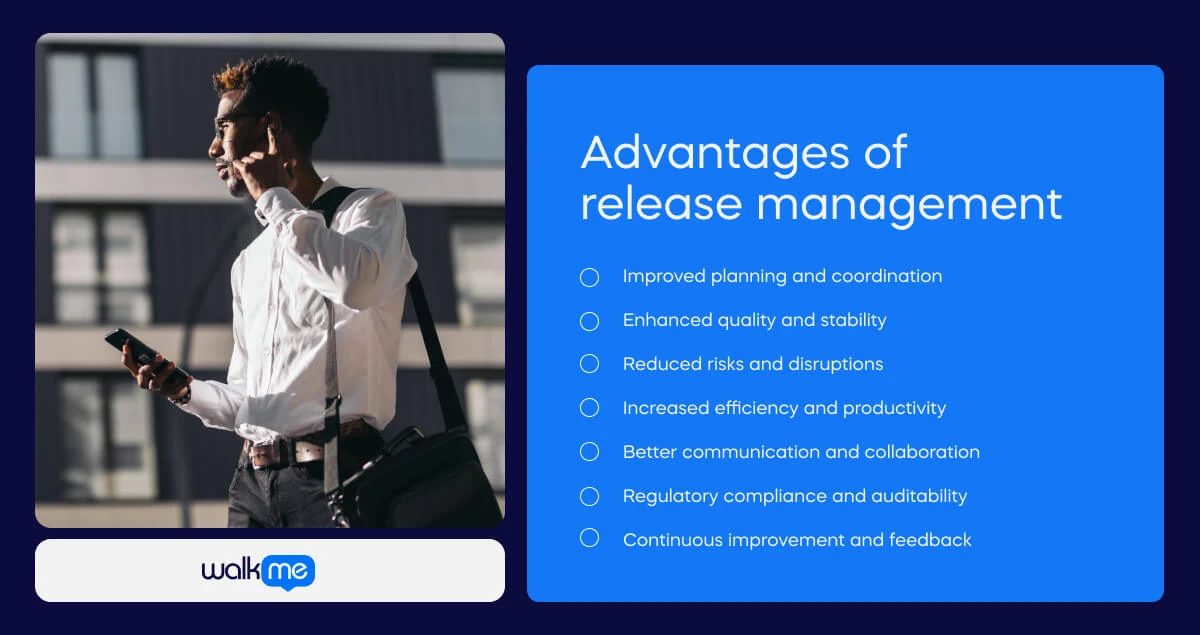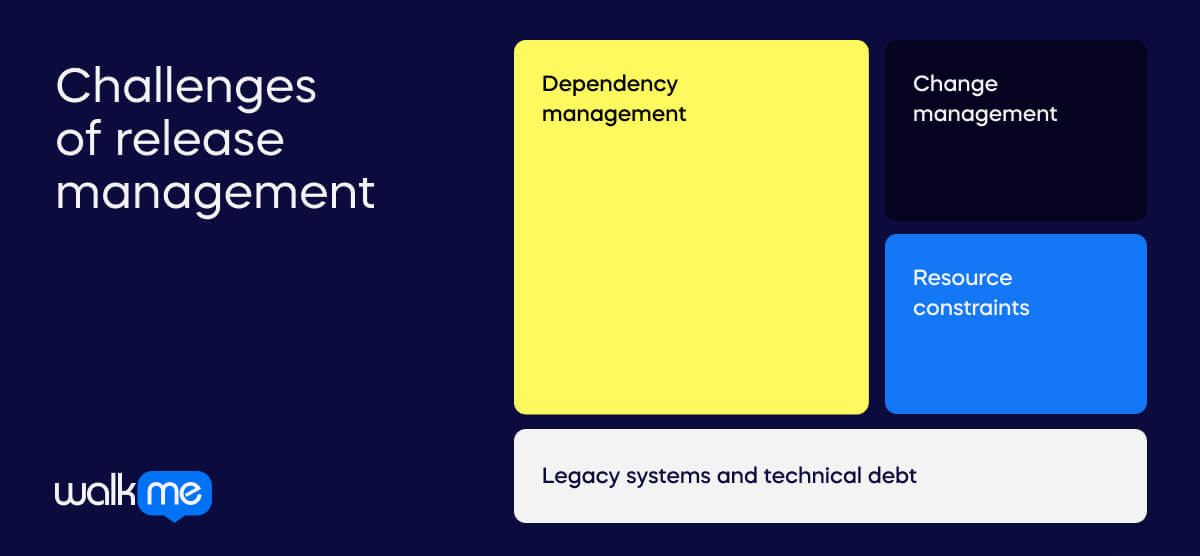What is release management?
Release management is a systematic process used in software development to plan, schedule, coordinate, and control the deployment of software releases across different environments, such as development, testing, staging, and production.

Table of contents
Its primary goal is to ensure the smooth and efficient delivery of software products or updates into production while minimizing risks and disruptions to users or systems. Effective release management helps organizations deliver high-quality software products to their customers more quickly and reliably, enabling them to respond to changing market demands and stay competitive. It also helps minimize the risks associated with software deployment by implementing standardized processes and controls for managing changes and ensuring consistency and stability across different environments. Key activities involved in release management typically include:
- Release planning: This involves defining the scope of the release, identifying the features or enhancements to be included, and establishing timelines and milestones for development, testing, and deployment.
- Version control: Managing and tracking different versions of software code and documentation to ensure that the correct versions are deployed at each stage of the release process.
- Environment management: Setting up and maintaining various development, testing, staging, and production environments to support the release process.
- Change management: Assessing and managing changes to the software and its environment to ensure they are properly evaluated, approved, and implemented without causing disruptions or conflicts.
- Testing and quality assurance: Conducting thorough software testing to identify and fix bugs, ensure compatibility with different platforms and configurations, and validate that it meets the specified requirements and quality standards.
- Deployment and rollback: Deploying the release into production environments in a controlled manner, monitoring its performance and stability, and having rollback procedures in place in case of any unexpected issues or failures.
- Communication and coordination: Facilitating communication and collaboration among different teams involved in the release process, including developers, testers, operations staff, and stakeholders, to ensure everyone is aligned and informed about the progress and status of the release.
How can DAPs help with release management?
The demand for using advanced technology solutions for software development processes already exists. For example, Gartner reveals that 78% of IT leaders are using, or intend to use, coding assistants for software development within the workplace. With a Digital Adoption Platform (DAP) like WalkMe, IT professionals can achieve such solutions and much more. Let’s look at how DAPs can support and streamline the release management process:
Onboarding and training
WalkMe can provide contextual guidance and training to release managers, developers, testers, and other stakeholders. This ensures they quickly grasp the release management process, tools, and best practices. New team members benefit from accelerated onboarding, as they receive real-time assistance during their learning curve. By equipping everyone with the necessary skills and knowledge, WalkMe ensures effective participation in the release process.
Task automation
Automating repetitive tasks is a forte of WalkMe. For release management, WalkMe can handle tasks like:
- Updating documentation: Automatically keeping release-related documents up-to-date.
| Let’s say you have a release notes document that needs to be updated whenever a new version of your product is deployed. Step 1: Whenever a new version is released, manually update the release notes document. Step 2: Use Task Automation to schedule a task that checks for new releases (e.g., by monitoring a specific folder or API endpoint). Step 3: If a new release is detected, trigger an action to update the release notes document with the latest information. Result: Your release notes stay current without manual intervention. |
- Creating release notes: Generating release notes based on predefined templates.
- Managing change requests: Streamlining the process by automating approvals and notifications.
- Executing deployment scripts: Ensuring consistency and accuracy during deployments.
By reducing manual effort, WalkMe minimizes errors and saves valuable time.
Process guidance
Step-by-step guidance and checklists are available for release managers and teams, thanks to DAPs like WalkMe. When created by the Centre of Excellence within the workforce, these guides ensure adherence to standardized release management processes and workflows. By following best practices, teams reduce the risk of errors or deviations during releases.
Integration with tools and systems
WalkMe seamlessly integrates with existing tools used in release management, such as version control systems, issue trackers, and collaboration platforms. The platform ensures data is synchronized in real-time, and workers can create automated notifications to enhance visibility and communication. Effective integration allows cross-platform workflows that ensure a unified experience for release managers and teams.
Performance analytics
With WalkMe, workers can monitor key performance metrics related to release management. These metrics include:
- Release cycle time: Measure the time from planning to deployment for each release.
- Deployment frequency: Track how often releases are deployed.
- Change success rate: Evaluate the success of changes introduced in each release.
- Mean time to recovery: Understand how quickly the system recovers from failures.
The platform also helps with the following:
- Identifying bottlenecks: By analyzing these metrics, release managers can pinpoint bottlenecks.
- For instance, if the release cycle time is consistently long, it may indicate inefficiencies that need addressing.
- Optimizing workflows: Armed with insights, release managers can optimize workflows.
- For example, if deployment frequency is low, they can streamline the deployment process.
- Continuous improvement: Release managers can iterate on processes based on real-time performance data.
User feedback and support
The WalkMe Surveys feature gathers feedback from release managers, developers, testers, and other stakeholders about their experiences with the release management process and tools. These insights can help identify pain points, usability issues, and areas for improvement, enabling organizations to make data-driven decisions and provide targeted support and training to address these challenges.
| Let’s take a look at the workflow that can be followed with data gathered during the release management journey: Feedback collection: WalkMe prompts release managers, developers, testers, and other stakeholders to provide feedback.This feedback could be related to their experiences with the release process or the tools used. Identifying pain points: By collecting feedback, organizations can identify pain points.For instance, if testers consistently report difficulties during a specific phase of the release, it becomes an area for improvement. Usability insights: WalkMe helps to uncover usability issues. If users struggle with certain features or steps, the feedback informs adjustments. Data-driven decisions: Armed with user feedback, organizations can make informed decisions.For example, if a particular tool receives negative feedback, it can explore alternatives or enhance its usability. Targeted support and training: Based on feedback patterns, targeted support and training can be provided. Whether it’s additional documentation, training sessions, or tool enhancements, WalkMe guides these efforts. |
Use cases for release management
Release management in business
Here are three examples of how release management can manifest in different business scenarios:
Software development company
In a software development company, release management involves coordinating and deploying new software releases to various environments. For example:
- Planning and scheduling the release of a new version of a web application, including features, bug fixes, and performance enhancements.
- Ensuring the release is thoroughly tested in different environments (e.g., development, staging, production) to verify functionality, compatibility, and performance.
- Coordinating with cross-functional teams, such as developers, testers, operations, and customer support, to ensure a smooth and successful release deployment.
- Implementing a rollback plan and monitoring the release post-deployment to address any issues or unexpected behavior.
E-commerce retailer
For an e-commerce retailer, release management involves managing the deployment of updates to the online shopping platform. For example:
- Planning and coordinating the release of new features, product updates, and promotional campaigns on the e-commerce website.
- Conducting extensive testing to ensure that the website functions correctly across different devices, browsers, and operating systems.
- Implementing a phased rollout strategy to gradually release updates to specific regions or customer segments while monitoring performance and customer feedback.
- Collaborating with marketing and sales teams to align release schedules with promotional activities and maximize the impact on sales and customer engagement.
Financial institution
In a financial institution, release management oversees the deployment of software updates to critical banking systems and applications. For example:
- Planning and coordinating the release of regulatory compliance updates, security patches, and new features for online banking platforms and mobile apps.
- Conducting rigorous testing and compliance checks to ensure that the software meets industry regulations, security standards, and customer privacy requirements.
- Coordinating with risk management and audit teams to assess the impact of the release on business operations, data integrity, and financial transactions.
- Implementing strict change control processes and maintaining detailed documentation to support audit trails and regulatory reporting requirements.
Success stories with release management

Here are three notable organizations that have leveraged the WalkMe platform to enhance their release management processes:
IBM
The global technology and consulting company has integrated WalkMe to streamline its release management workflows. Using WalkMe’s features, they can track key metrics, identify bottlenecks, and continuously improve their release cycles.
Nestlé
The leading food and beverage company uses WalkMe to optimize its software releases. With WalkMe’s user feedback collection capabilities, Nestlé gathers stakeholder insights, identifies pain points, and ensures a smooth transition during major releases.
ThermoFisher Scientific
The life sciences and diagnostics company benefits from WalkMe’s data-driven approach. They use WalkMe to analyze software usage, facilitate feature adoption, and reduce IT complexity during release cycles.
Release management vs deployment management
Release management and deployment management are two essential aspects of software development and delivery, often intertwined but with distinct focuses and responsibilities.
- Release management involves the planning, scheduling, coordinating, and controlling of software releases throughout their lifecycle.
- Deployment management focuses specifically on deploying software or updates into the production environment.
Let’s dig into a comparison of the terms:
| Release management | Deployment management | |
| Focus | Primarily concerned with managing the overall release process, including planning, scheduling, coordinating, and controlling the deployment of software releases across different environments. | Specifically, it focuses on the technical aspects of deploying software releases into production environments. |
| Scope | Encompasses the entire lifecycle of a release, from initial planning and development through testing, deployment, and post-release monitoring. | Deals with the execution and coordination of deployment activities, such as installing, configuring, and verifying the functionality of software components in target environments. |
| Activities | Includes activities such as defining release scope, coordinating with stakeholders, managing release schedules, conducting risk assessments, ensuring compliance with regulatory requirements, and communicating release status to relevant parties. | Involves tasks such as preparing deployment packages, executing deployment scripts or automation workflows, monitoring deployment progress, verifying deployment success, and addressing any deployment-related issues or failures. |
| Goals | Aims to ensure that software releases are delivered smoothly, efficiently, and reliably, meeting business objectives while minimizing risks and disruptions. | Aims to ensure that software releases are deployed correctly and efficiently, with minimal downtime and impact on users or systems, while maintaining the integrity and stability of production environments. |
Advantages of release management

Release management offers several advantages to organizations:
Improved planning and coordination
Release management provides a structured approach to planning and coordinating software releases, allowing organizations to align release schedules with business objectives, customer needs, and market demands. This helps ensure that releases are delivered on time and within budget.
Enhanced quality and stability
By implementing standardized testing, validation, and deployment processes, release management helps improve the quality and stability of software releases. Thorough testing and validation minimize the likelihood of defects, bugs, and performance issues in production environments, leading to better user experiences and higher customer satisfaction.
Reduced risks and disruptions
Release management helps minimize risks and disruptions associated with software deployment by implementing change control processes, conducting impact assessments, and having rollback procedures in place. This allows organizations to mitigate the potential impact of failed releases or unexpected issues, minimizing downtime and business disruptions.
Increased efficiency and productivity
Streamlining the release process through automation, collaboration tools, and standardized workflows improves efficiency and productivity. Release management reduces manual effort, eliminates redundant tasks, and accelerates the delivery of software releases, enabling organizations to innovate and respond to market changes more quickly.
Better communication and collaboration
Release management fosters communication and collaboration among cross-functional teams involved in the release process, such as developers, testers, operations, and stakeholders. Improved communication ensures everyone is aligned, informed, and working towards common goals, reducing misunderstandings and conflicts.
Regulatory compliance and auditability
For organizations operating in regulated industries, release management helps ensure compliance with regulatory requirements and industry standards. Organizations can demonstrate accountability, transparency, and adherence to compliance guidelines during regulatory audits by maintaining detailed documentation, audit trails, and change records.
Continuous improvement and feedback
Release management facilitates continuous improvement by capturing feedback, analyzing performance metrics, and identifying areas for optimization in the release process. Organizations can use this feedback loop to iteratively refine their release management practices, drive innovation, and deliver greater customer value over time.
Challenges of release management

While release management offers numerous benefits, it also presents several challenges that organizations may encounter:
Dependency management
Identifying and managing dependencies between software components, libraries, and external systems is crucial for successful release management. However, tracking dependencies accurately and ensuring compatibility across different versions can be difficult, especially in environments with frequent updates or changes.
Change management
Implementing changes to software systems as part of the release process requires careful planning, documentation, and coordination. Managing change requests, assessing their impact, and obtaining approvals can be time-consuming and prone to errors, especially in organizations with complex approval processes or regulatory requirements.
Resource constraints
Limited resources, such as time, budget, and personnel, can pose challenges for release management. Balancing competing priorities, allocating resources effectively, and meeting tight deadlines while maintaining quality standards can be difficult, especially for organizations with limited capacity or competing initiatives.
Legacy systems and technical debt
Organizations with legacy systems or technical debt may face additional challenges in release management. Legacy systems often have outdated technologies, complex architectures, and legacy dependencies, making release management more difficult and risky. Addressing technical debt and modernizing legacy systems can mitigate these challenges over time.
The future of release management
Release management is critical in ensuring the smooth and efficient delivery of software products and updates. Understanding its significance in business scenarios is imperative, as it directly impacts operational effectiveness and customer satisfaction. We’ve delved into various aspects of release management, including its definition, advantages, challenges, and the pivotal role of Digital Adoption Platforms (DAPs) in enhancing its efficiency. We explored how DAPs can revolutionize release management processes by providing seamless integration, comprehensive training, and real-time user guidance, mitigating risks and accelerating adoption.
The future of release management looks bright with the continued integration of DAPs. These platforms are poised to further streamline processes, enhance user experiences, and drive digital transformation initiatives across industries. As businesses strive for agility and innovation, harnessing the power of DAPs will be instrumental in achieving and maintaining competitive advantage in the dynamic landscape of software development and deployment. Spending on application development software is expected to reach $30.7 billion by 2027, indicating that processes like release management will likely improve with technology solutions such as DAPs. By leveraging the insights and strategies discussed in this glossary, organizations can confidently navigate release management’s complexities, driving success in their digital initiatives and delivering value to stakeholders.